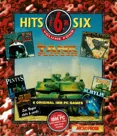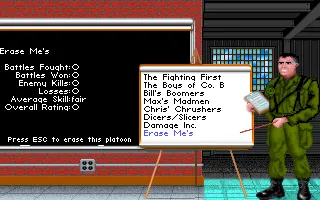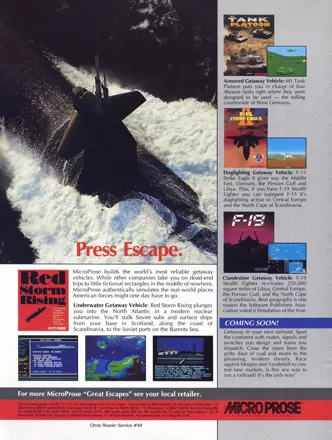M1 Tank Platoon
Description official descriptions
A very encompassing game that allowed players to issue orders to Tanks, AA units, Aircraft, Artillery and Infantry in a campaign against Warsaw Pact units in Europe, while specifically controlling a platoon of 4 M1 tanks. The player could jump into the position of the driver, gunner or commander of any of the tanks to view the world from a 1st person perspective, or work from a tactical map to command all his forces. Characters in the M1 platoon actually increased in skill as they survived battles.
Spellings
- M-1 Tank Platoon - Alternate spelling
Groups +
Screenshots
Promos
Credits (DOS version)
23 People · View all
| Game Design | |
| Original Programming | |
| Original Graphics | |
| Music | |
| Sound Effects | |
| Speach and Ad Lib Sound | |
| Quality Assurance | |
| Playtesting | |
| Manual Written by | |
| Manual Design by | |
| Manual Graphics by | |
| [ full credits ] | |
Reviews
Critics
Average score: 83% (based on 22 ratings)
Players
Average score: 3.8 out of 5 (based on 28 ratings with 4 reviews)
An underappreciated classic with innovations that were way ahead of its time.
The Good
The gameplay of M1 Tank Platoon is fabulous. Its gameplay was innovative and complex for the year it was released, and it still holds up well today some 12 years later. This was one of the very first PC games I ever bought after buying my first IBM clone (a 25MHz 486) in 1992. Over the past 10 years, I've upgraded my computer twice, moving to a 200Mhz Pentium Pro in 1996, and then a 1GHz Athlon in 2000. And during that time, M1 Tank Platoon has always had a permanent place on my hard drive. This is a distinction it shares with only a few other games: Doom II, Civ2, and System Shock. It's just that good.
Each combat zone had a "Blue Base" and a "Red Base." The Blue Base was your field HQ. The Red Base was the enemy field HQ. Your mission could either be offensive, defensive, or neutral. Offensive missions required you to capture the enemy base, defensive missions required you to defend your own base, and neutral missions could go either way (the enemy was advancing on your base, so you could either advance on his base or defend your own). There were also occasional escort missions where you would rendezvous with halftracks and escort them to the edge of the map where they would retreat.
One of the interesting things about the game was that your mission objectives were based on how well you did in the previous missions. If you successfully achieved the mission objectives for one mission, your next mission would place you firmly on the offensive. If, on the other hand, you failed to achieve your objectives in one mission, your next mission would find you on the defensive. And as you built up a string of successful (or unsuccessful) missions, the missions would get tougher and tougher.
Each successful mission in a row would be tougher than the last. There would be more enemies defending your target objective, and they would have better equipment than previous defenders in earlier missions. This was meant to simulate the fact that you were getting closer and closer to the heart of the enemy's territory. You'd polished off their weak outlying defenses in the early missions, you'd cut through stronger defenses in the middle missions as you neared their stronghold, and now you were facing their elite forces as they pitched an all-out effort to defend their final positions. After about ten consecutive successful missions, you would be declared the winner of a "campaign" and be hailed as a hero by a cheering crowd. The war would still be going on around you, and you would have more campaigns to fight over your 99-game career, but for now you could relax secure in the knowledge that you had achieved a lasting victory in your particular theater of war.
Similarly, a string of unsuccessful missions would also get tougher as they mounted up. One failed mission would be a minor setback, resulting in the enemy sending out a small, weak exploratory force to harry you and test your resolve. If you continued to fail at your missions, the enemy, sensing a weakness in your defensive emplacements, would grow bolder and would begin flinging more powerful units at you in increasing numbers, all in an effort to polish you off once and for all. After about eight or ten consecutive failed missions, you would "lose" a campaign and be recalled for desk duty.
This variable mission and variable toughness aspect of the game, combined with the reasonably broad variety of mission types available, gave M1 Tank Platoon a high replay value.
Another interesting facet of the game was that you could control almost any of your units from a 1st person perspective (helicopters and infantry were immune to such direct control, as I recall, but everything else was fair game). I would frequently let the AI do all the combat duty for my four M1 tanks while I drove and fought from a mobile rocket launcher or a mobile artillery unit using the 1st-person view.
This 1st-person view is, for some reason, never remarked upon. When people think of the progenitors of the First Person Shooter genre, they think of Doom, and Wolfenstein 3-D, and the Ultima Underworld series. But M1 Tank Platoon featured innovations which were wildly ahead of their time and which, while we now take them for granted, wouldn't be seen in other games for years:
- The landscape was fully 3-D. You drove up and down and around hills, around barns, past trees and windmills, etc. It wasn't hi-res, but it was 3-D.
- The 1st-person view, while common in today's games, was generally considered computationally too taxing for the computers of the late 1980s. M1 Tank Platoon's true 1st-person view was therefore fairly revolutionary for the time.
- The opponents were 3-D models constructed of polygons, something that wouldn't be seen again until Descent, and wouldn't be common until the era of Quake.
- You could view any of your units from a 3rd-person perspective, complete with a fully rotatable camera that could be set to view your units from any angle.
Pretty amazing for a game that predates Doom by four years, predates Descent by five years, and was designed to be played on an 8MHz 286 computer with 384 kilobytes of RAM.
The Bad
The graphics are a tad monotonous, even for the year the game was released. Green green green green green, everywhere you look.
The Bottom Line
A great tank combat simulation, well deserving of the "classic" designation.
DOS · by Afterburner (486) · 2001
The Good
I bought this one in the middle 1990s in a budget edition, and I got much more than I expected. Since I got my first IBM PC clone, one of the genres I was more eager to try was war simulations, because you rarely got them in 8 bit platforms, and when you did they were versions so cut down it took away most of the fun.
With this one, I expected an action oriented game (didn't we all?) with focus on tank mechanics. Instead, I got something much more complex and big, something like a "land war simulation". Yes, the tanks take the central stage, but rather than taking control of one vehicle you'll spend most of your time on the general map, directing and coordinating the titular tank platoon as well as support units such as helicopters, rocket artillery and others.
There's still tons of action, because once you establish contact with enemy units you'd better take control of the nearest vehicle and gunner, but be warned: this is a completely different beast than more arcade oriented titles such as the "Armored Fist" series.
The game also makes the most of its mechanics, despite fitting in just one 1.44 Mb. disk. Friendly and enemy AI are pretty good. Enemy AI can be tweaked, and as for friendly AI your platoon members will get better every time they survive a battle.
The mission objectives, terrain and availability of support units also make every single battle completely different, despite the similarly looking green scenario.
The Bad
So yes, "M1 Tank Platoon" is a great game, but with still some room for improvement. Let me see.
The game was developed with only one scenario in mind, a vast Soviet offensive against western Europe. It was a very feasible situation, maybe second only to an all out nuclear confrontation. Both Soviet Russia and NATO had plenty of tanks in the area, in prevision of exactly this situation, and some sources claim the Soviets had up to 10 tanks for every NATO vehicle. Had such a war erupted, it sure would have been one of the defining events in the XXth century.
This however means that we'll be stuck in a single scenario, European looking green pastures and hills, without desert or jungle scenarios at all. MicroProse later launched a desert-looking version of the game to capitalise on the first gulf war, but that edition is harder to find.
Also, the game only gives you vehicles as enemies or support units: tanks, BMPs, trucks... where the hell is the infantry? Whenever it appears in the briefings, it just means you'll get to destroy some armoured transport vehicles, but infantry is never found in the scenario on its own, nor included among your support units.
The copy protection scheme is also a bit annoying... at the beginning of every game you'll have to check your manual and identify a couple of tanks. Like in some other MicroProse titles, you can learn to identify some of the most distinctive ones, but it still seems to me like a small nuisance.
The Bottom Line
If instant action and top level graphics and sounds are important for you, this is not the game you're looking for. On the other hand, if you don't mind playing an old game or you consider yourself an armchair general, there very few games that can offer you as much as this one in just one package. The game has a sequel with better graphics and more compatible with modern systems, but I'm told the game mechanics are essentially the same.
DOS · by Neville (3559) · 2017
The Good
This was the first Tank Simulator that was technically accurate. Until that time tank games were shooters where one tank would drive around a flat world shooting scores of enemy tanks. But M1 Tank Platoon gave us realistic tanks, realistic weapons, laser rangefinders, infantry, artillery and air support. You'd fight realistic military actions. Like F-19, the manual is awesome and really sucks you in. The gameplay was extremely good. It was also (I think) the first such game that was truly 3D.
The Bad
The graphics were very simple, but they were real 3D.
The AI wasn't bad, but your own tanks often did stupid things (like exposing their flanks to the enemy). Often the enemy T-80s would just sit there while you picked them off one by one. But the battles were usually reasonably matched; neither too easy nor too hard.
But for the 1980s and the first of its kind, what do you expect?
The Bottom Line
A trailblazer realistic military simulator. Brilliant gameplay that kept you coming back for more. Even after 15 years, I'll still get into it for the odd campaign.
DOS · by B Jones (14) · 2006
Trivia
Graphics
Around Desert Storm, MicroProse released a "bundle" called "Allied Forces, which contains Gunship and M1 Tank Platoon, but with a patch to make the terrain yellow/brown like Kuwait instead of the "green" of Europe.
Troops
You don't just control your own platoon of 4 tanks. Sometimes additional forces will be assigned to you, anything from infantry (Bradley IFVs and M-113 APCs) and missile carriers (ITV-improved TOW vehicle) to A-10 or helicopter support. Sometimes you may even see some M-60 tanks assigned to you! Artillery is also available on call depending on what's available (HE, smoke, etc.).
Awards
- Amiga Joker
- Issue 01/1991 – #5 Best Simulation Game in 1990
- Computer Gaming World
- November 1991 (Issue #88) – Introduced into the Hall of Fame
- September 1990 (Issue #74) - Simulation Game of the Year
- November 1996 (15th anniversary issue) - #32 in the “150 Best Games of All Time” list
- EMAP
- Golden Joystick Rewards 1990: Winner Best Simulation.
- Power Play
- Issue 01/1990 - #2 Best Simuation in 1989
Information also contributed by Adam Baratz and PCGamer77.
Analytics
Identifiers +
Contribute
Are you familiar with this game? Help document and preserve this entry in video game history! If your contribution is approved, you will earn points and be credited as a contributor.
Contributors to this Entry
Game added by Jeff Sinasac.
Windows, Linux, Macintosh added by Plok. Atari ST added by Martin Smith. PC-98, Amiga added by Terok Nor.
Additional contributors: Kasey Chang, formercontrib, Patrick Bregger, Plok, Jo ST.
Game added May 27, 2000. Last modified November 14, 2024.























